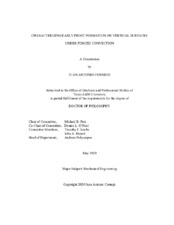| dc.description.abstract | This investigation characterized early frost formation by quantifying the velocity of the aggregate freezing front and examining the underlying factors that have a direct effect on it. The experiments were carried out under forced convection conditions (Re≈1.8x105 ) with a free-stream air temperature and velocity of 5 °C and 5 m/s, respectively while relative humidity test values were 60%, 70% and 80%. Four surfaces with different contact angles were tested with the surfaces being chemically treated superhydrophobic aluminum, untreated aluminum, untreated copper and untreated iron with surface contact angles of 148°, 89°, 88°, and 45°, respectively. It was found that the superhydrophobic aluminum exhibited the lowest values of the freezing velocity while the untreated iron had the fastest overall values. On average, the chemically treated aluminum had a freezing velocity of 35.5 μm/s while the untreated iron exhibited a freezing velocity of 49.9 μm/s, representing a 29% increase over the superhydrophobic aluminum sample. Several factors contributed to this increase in velocity including droplet population density, droplet size and crystal growth rate. The data also indicated that the freezing velocity and other freezing characteristics were largely affected by the surface temperature, where decreasing temperature resulted in an increase of the freezing velocity and other characteristics such as the crystal growth rate. The ambient relative humidity also had a mild effect on the freezing velocity and other freezing factors, though it was not as pronounced as the effects due to the surface temperature. It was concluded that as the hydrophobicity of the surface increased, the freezing velocity decreased, supporting the idea that hydrophobic surfaces can be effective in delaying frost formation. | en |


